15-8 Comets originate either from the Kuiper belt or from the Oort cloud
Both comets and Kuiper belt objects are mixtures of ice and rock that must have formed in the outer solar system. (Had they formed in the warm inner solar system, they would not have included ices.) But most Kuiper belt objects have relatively circular orbits that lie close to the plane of the ecliptic, while comets have very elongated orbits that are often steeply inclined to the ecliptic. What gives comets their distinctive orbits? As we will see, the answer to this question depends on whether the comet’s orbital period is relatively short or relatively long.
Jupiter-Family Comets and the Kuiper Belt
As we saw in Section 14-10, the gravitational effects of Neptune shape the orbits of objects in the Kuiper belt. Most of these objects are found between the orbit of Pluto (where an object makes two orbits for every three orbits of Neptune) and about 50 AU from the Sun (where an object makes one orbit for every two orbits of Neptune).
However, collisions between Kuiper belt objects can break off relatively small chunks. Gravitational perturbations from Neptune can occasionally launch one of these chunks into a highly elliptical orbit that takes it close to the Sun. When one of these chunks approaches the Sun, it develops a visible tail and appears as a comet. These are called Jupiter-family comets because their orbits tend to be influenced strongly by Jupiter’s gravitational pull. Jupiter-family comets orbit the Sun in fewer than 20 years. One example is Comet Tempel 1, which has an orbital period of 5.5 years.
There may be tens of thousands of objects in the Kuiper belt that could eventually be perturbed into an elongated orbit and become comets. It is also thought that a few of these refugees from the Kuiper belt have been captured by the gravitational pull of Saturn, becoming that planet’s small outer satellites (see Section 13-10).
Short-Period Comets, Long-Period Comets, and the Oort Cloud
The majority of comets are short-period comets, with orbital periods between 20 and 200 years, and long-period comets, which take more than 200 years to complete one orbit around the Sun. Comet Halley, shown in Figure 15-27a, has an orbital period of 76 years and is a short-period comet; Comet Hyakutake (see Figure 15-25) is a long-period comet that takes about 70,000 years to complete one orbit.
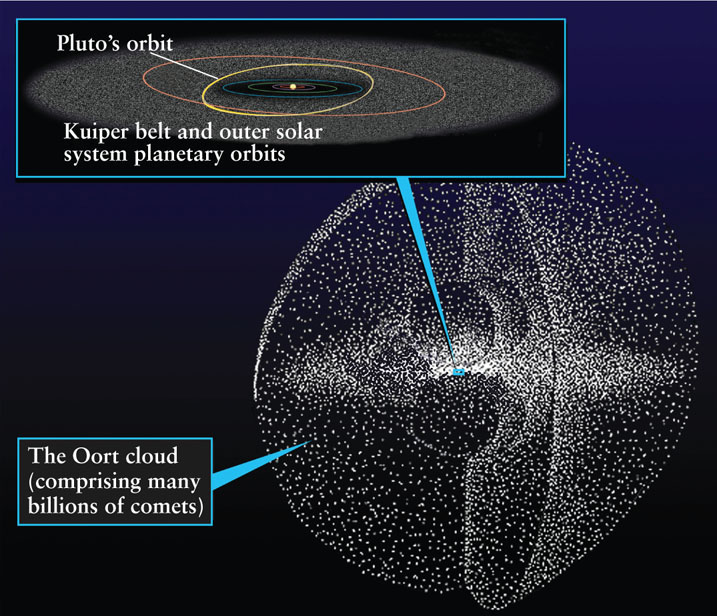
The short-period comets are thought to come from the Kuiper belt (Figure 15-35). Due to their longer periods, the long-period comets are thought to come from much farther out—a reservoir of icy objects that extends from the Kuiper belt to some 50,000 AU from the Sun, or about one-fifth of the way to the nearest star. This reservoir, first hypothesized by Dutch astronomer Jan Oort in 1950 and now called the Oort cloud, is thought to contain two vast arrangements of comets around the Sun—an inner doughnut-shaped distribution and an outer spherical distribution. The outer spherical distribution was proposed in order to account for the observation that long-period comets can have large orbital inclinations relative to the ecliptic (the orbital plane of the planets).
Because astronomers discover long-period comets at the rate of about one per month, it is reasonable to suppose that there is an enormous population of comets in the Oort cloud. The number of Oort cloud objects greater than 1 km in size range is as high as 5 trillion (5 × 1012). Only such a large reservoir of comet nuclei would explain why we see so many long-period comets, even though each one takes tens of thousands of years to travel once around its orbit. Even with trillions of “dirty snowballs” in the Oort cloud, their average separation from each other is about 10 million km. Taken together, the total mass in the Oort cloud is equal to about 5 Earth masses.
Because the Oort cloud is so distant, direct detection of objects in the Oort cloud is a daunting challenge. The best candidate Oort cloud object is the trans-Neptunian object Sedna (Figure 14-20), with an aphelion of 960 AU.
The Oort cloud was probably created 4.56 billion years ago from numerous icy planetesimals that orbited the Sun in the vicinity of the newly formed Jovian planets. When the outward migration of Saturn, Uranus, and Neptune deflected these icy objects inward toward Jupiter, Jupiter’s large gravity catapulted most of these objects clear out of the solar system. However, a small portion of these icy objects failed to leave the solar system entirely and formed the Oort cloud (Section 8-6). Gravitational perturbations from nearby stars could have tilted the planes of the orbits in all directions, giving the Oort cloud its spherical shape. Computer simulations even suggest the possibility that the Sun could have captured a substantial fraction of the existing Oort cloud objects from the protoplanetary disks of other stars.
Changing a Comet’s Orbit
The distinction between long-period, short-period, and Jupiter-family comets can be blurred by the effects of gravitational perturbations. During a return trip toward the Sun, an encounter with a Jovian planet may force a comet into a much larger orbit. Alternatively, such an encounter can move a long-period comet into a smaller orbit (Figure 15-36). Several comets have been perturbed in this way into orbits that always remain within the inner solar system. One example is Comet Tempel, which now orbits between Mars and Jupiter.
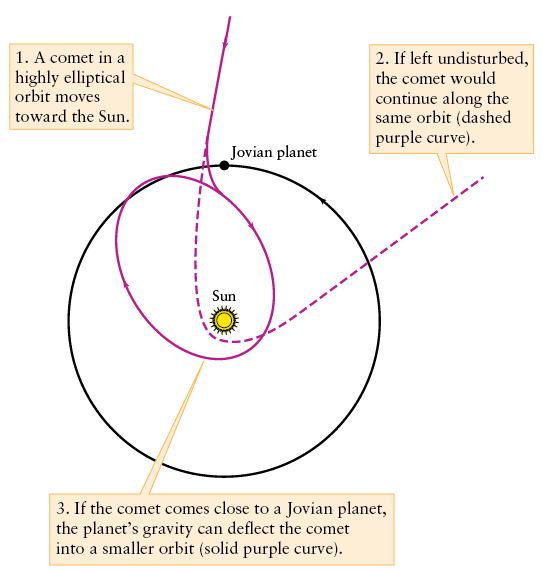
Comet Breakup and Meteor Showers
Because they evaporate away part of their mass each time they pass near the Sun, comets cannot last forever. A typical comet may lose about 0.5% to 1% of its ice each time it passes near the Sun. Hence, the ice completely vaporizes after about 100 or 200 perihelion passages, leaving only a swarm of dust and pebbles. Astronomers have observed some comet nuclei in the process of fragmenting (Figure 15-37).
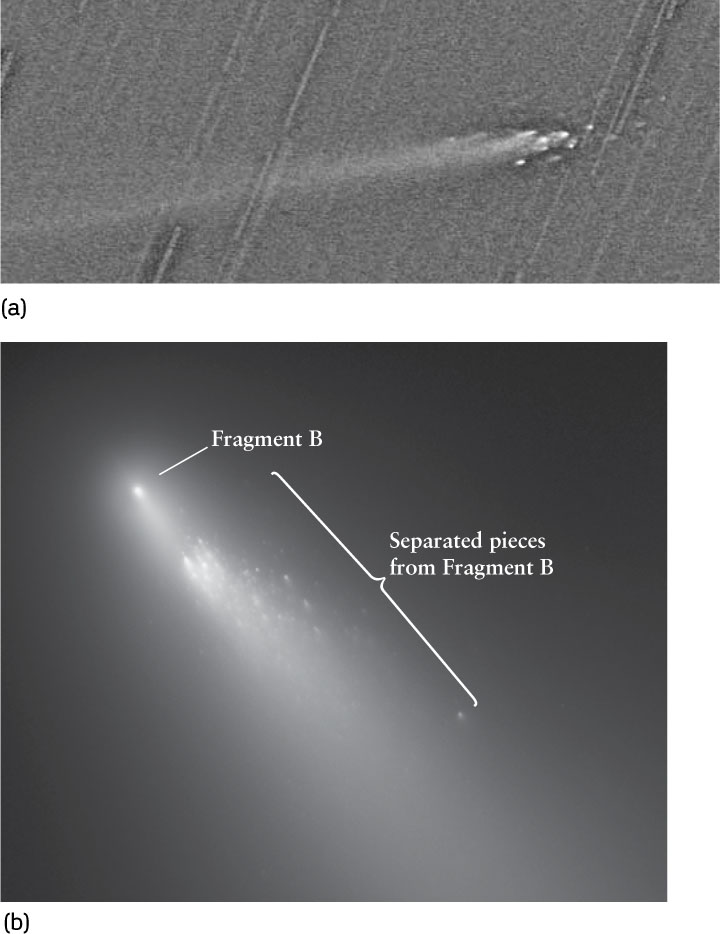
The Fragmentation of Comets (a) Comet LINEAR was discovered by the Lincoln Near Earth Asteroid Research (LINEAR) project in 1999. As it passed the perihelion of its orbit in July 2000, Comet LINEAR broke into more than a dozen small fragments. These continue to orbit the Sun along the same trajectory that the comet followed prior to its breakup. This image was made using the Very Large Telescope (see Figure 6-18). (b) This comet, with a 5.4-year orbit, has been coming apart for decades. In 2006, it further fragmented after passing perihelion. One piece, Fragment B, shed at least 30 smaller pieces, shown here.
Comets eventually break apart, and their fragments give rise to meteor showers
One remarkable comet, called Shoemaker-Levy 9, broke apart for a different reason. As the comet swung by Jupiter in July 1992, the giant planet’s tidal forces tore the nucleus into more than 20 fragments. Jupiter’s gravity then deflected the trajectories of these fragments so that they plummeted into the planet’s atmosphere (Figure 15-38).
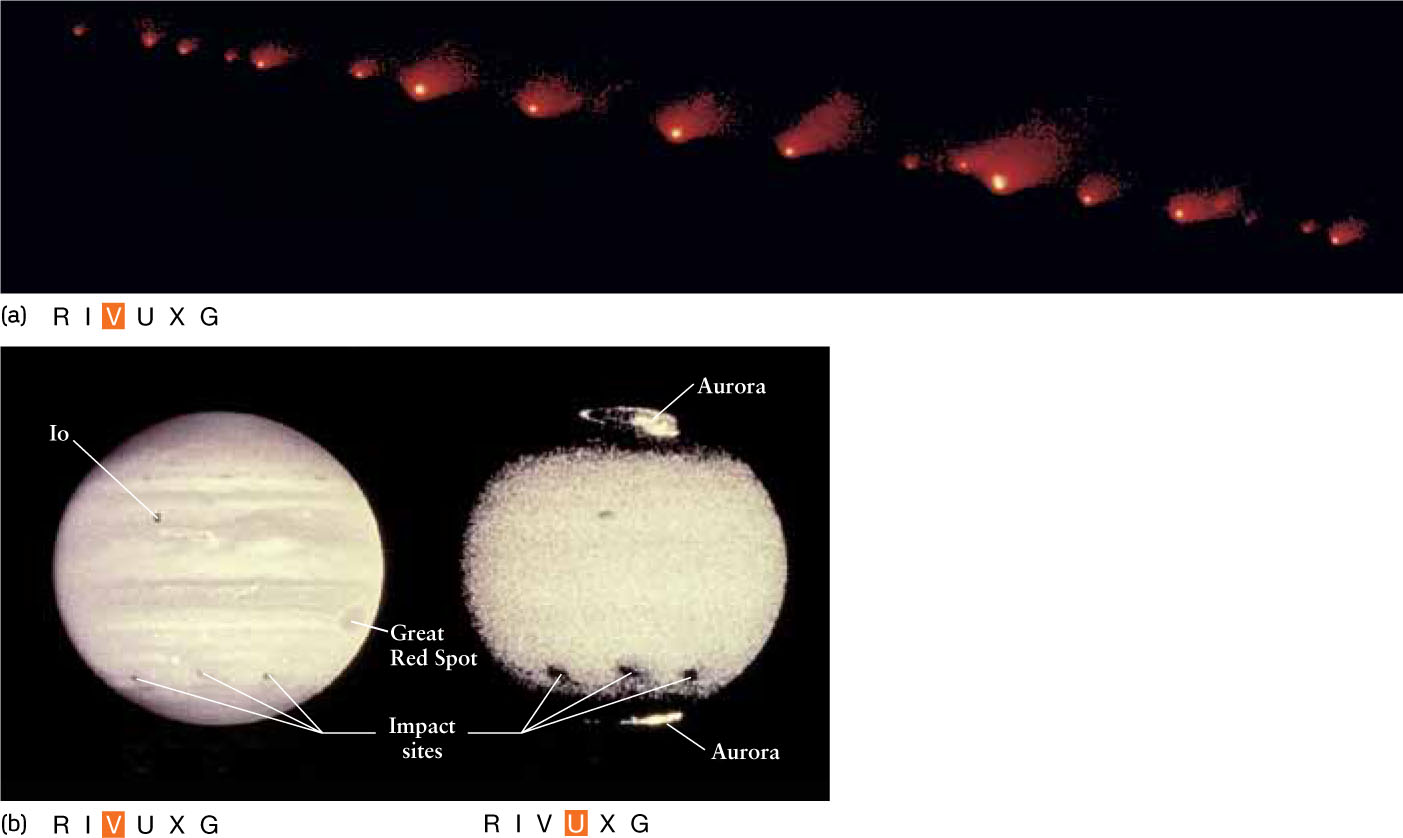
As a comet’s nucleus evaporates, residual dust and rock fragments form a meteoritic swarm, a loose collection of debris that continues to circle the Sun along the comet’s orbit (Figure 15-39). If Earth’s orbit happens to pass through this swarm, a meteor shower is seen as the dust particles strike Earth’s upper atmosphere. Nearly a dozen meteor showers can be seen each year (Table 15-1). Two of the bigger meteor showers—Perseids in summer and Geminids in winter—have almost a meteor per minute, which makes for great viewing.
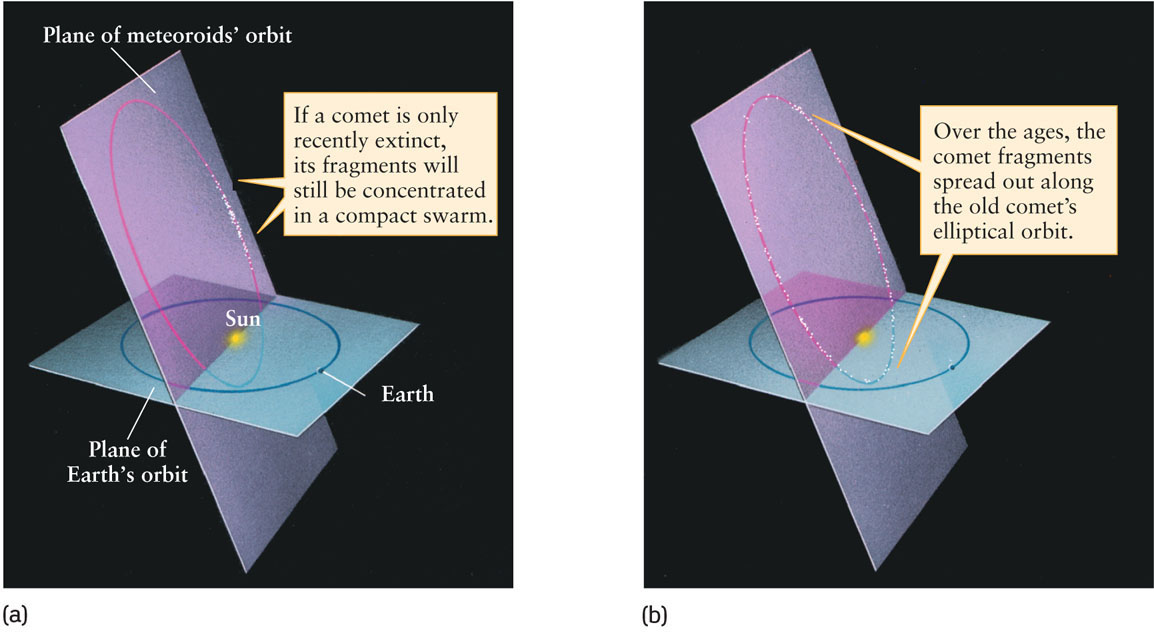
| Shower name | Date of maximum intensity* | Typical hourly rate | Average speed (km/s) | Radiant constellation |
|---|---|---|---|---|
| Quadrantids | January 3 | 40 | 40 | Boötes |
| Lyrids | April 22 | 15 | 50 | Lyra |
| Eta Aquarids | May 4 | 20 | 64 | Aquarius |
| Delta Aquarids | July 30 | 20 | 40 | Aquarius |
| Perseids | August 12 | 50 | 60 | Perseus |
| Orionids | October 21 | 20 | 66 | Orion |
| Taurids | November 4 | 15 | 30 | Taurus |
| Leonids | November 16 | 15 | 70 | Leo |
| Geminids | December 13 | 50 | 35 | Gemini |
| Ursids | December 22 | 15 | 35 | Ursa Minor |
| *The date of maximum intensity is the best time to observe a particular shower, although good displays can often be seen a day or two before or after the maximum. The typical hourly rate is given for an observer under optimum viewing conditions. The average speed refers to how fast the meteoroids are moving when they strike the atmosphere. The radiant indicates which constellation, and thus the direction, the meteors appear to come from. | ||||
CONCEPT CHECK 15-10
What motivated the Oort cloud hypothesis of a distant collection of icy objects?
From Kepler’s third law, the longer the orbital period, the larger the semimajor axis of the orbit. The short-period comets already orbit beyond Neptune in the Kuiper belt, and the long-period comets require a collection of objects much farther out; this is called the Oort cloud.
